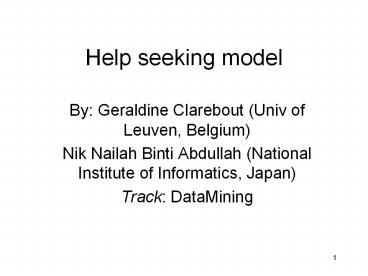Help seeking model PowerPoint PPT Presentation
1 / 13
Title: Help seeking model
1
Help seeking model
- By Geraldine Clarebout (Univ of Leuven, Belgium)
- Nik Nailah Binti Abdullah (National Institute of
Informatics, Japan) - Track DataMining
2
Help Seeking Model
- What is it?
- Describes students ideal help seeking behavior.
It determines - what type of action the students should ideally
perform - The number of steps of actions so far on the step
- The number of time students spends answering
3
Help Seeking Model
We are here!
4
Research question
- Do different patterns in help seeking correlate
with students attitudes about the cognitive
tutor? - We think so, what do you think?
5
Method
- Data from Ryan S. Baker PhD.
- Environment
- Geometry scatter plot.
6
The Analysis
- Learning to work with Excel, Pivot Table.
- Building rules.
- Try step abuse
- 1) Too fast (VARTF)
- If not first attempt 1, AND time lt.10, AND if
answer 0 then too fast - If not first attempt 0 And if time lt.7, And
if answer 0 then too fast - 2)Guess quickly
- If probability gt.80, and if time lt.7, and if
answer 1, (then guessing)) gt VARguess - If errors gt2 then help is need, if help requested
0, and if answer1) then guessing gtVARguess2 - (answer can be right or wrong when guessing but
we only see it as a problem for guessing when the
answer is correct, because then a student can
think he actually knows the problem but he
doesnt necessarily)
7
Results
- Correlations
VARTF VARguess VARguess2
VARTF 1 .007 .736
VARguess 1 .225
VARguess2 1
8
Results
- Descriptives
Min Max Mean SD
VARFT 1 22,13 8,55 4,62
VARguess 0 6,32 2,52 1,39
VARguess2 0 15,18 6,45 2,88
9
Results
- For each of the variables (i.e.,VARTF)
- We divided student into two groups high or low
scores on VARTF,VARguess,VARguess2 median split. - We defined 9 groups based on this 3 variables.
- E.g., high on the 3 variables or high on 1
variable and low on 1 variable.
10
Results
Fig 2. Histogram showing the patterns of the VAR
with the count of hi/low.
11
Results
- Correlation with the attitude data?
- Remains mystery.
12
Conclusion and perspectives
- 18 try step abuse.
- 17.5 for high on guessing and low on the other
ones. - 17.5 high for too fast and high on guess2 and
low on guess. - 14.4 low on all of the variables.
13
Conclusion and perspectives
- The does not explain why students has the
tendency to try step abuse. - What is the relationship of try step abuse with
the other help seeking factors? - What is the relationship with students attitude?

